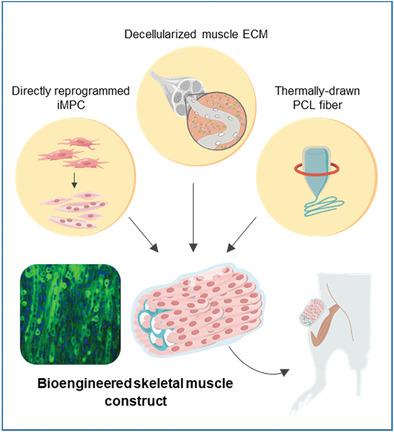当前位置:
X-MOL 学术
›
Adv. Mater.
›
论文详情
Our official English website, www.x-mol.net, welcomes your
feedback! (Note: you will need to create a separate account there.)
Functional Skeletal Muscle Regeneration with Thermally Drawn Porous Fibers and Reprogrammed Muscle Progenitors for Volumetric Muscle Injury
Advanced Materials ( IF 27.4 ) Pub Date : 2021-02-19 , DOI: 10.1002/adma.202007946 Yoonhee Jin 1 , Dena Shahriari 2, 3 , Eun Je Jeon 1, 4 , Seongjun Park 2, 3, 5, 6 , Yi Sun Choi 1 , Jonghyeok Back 7 , Hyungsuk Lee 7 , Polina Anikeeva 2, 3, 8, 9 , Seung-Woo Cho 1, 10, 11
Advanced Materials ( IF 27.4 ) Pub Date : 2021-02-19 , DOI: 10.1002/adma.202007946 Yoonhee Jin 1 , Dena Shahriari 2, 3 , Eun Je Jeon 1, 4 , Seongjun Park 2, 3, 5, 6 , Yi Sun Choi 1 , Jonghyeok Back 7 , Hyungsuk Lee 7 , Polina Anikeeva 2, 3, 8, 9 , Seung-Woo Cho 1, 10, 11
Affiliation

|
Skeletal muscle has an inherent capacity for spontaneous regeneration. However, recovery after severe injuries such as volumetric muscle loss (VML) is limited. There is therefore a need to develop interventions to induce functional skeletal muscle restoration. One suggested approach includes tissue‐engineered muscle constructs. Tissue‐engineering treatments have so far been impeded by the lack of reliable cell sources and the challenges in engineering of suitable tissue scaffolds. To address these challenges, muscle extracellular matrix (MEM) and induced skeletal myogenic progenitor cells (iMPCs) are integrated within thermally drawn fiber based microchannel scaffolds. The microchannel fibers decorated with MEM enhance differentiation and maturation of iMPCs. Furthermore, engraftment of these bioengineered hybrid muscle constructs induce de novo muscle regeneration accompanied with microvessel and neuromuscular junction formation in a VML mouse model, ultimately leading to functional recovery of muscle activity.
中文翻译:

利用热拉多孔纤维和重编程肌肉祖细胞实现体积肌肉损伤的功能性骨骼肌再生
骨骼肌具有自发再生的固有能力。然而,严重损伤(例如体积肌肉损失(VML))后的恢复是有限的。因此,需要开发干预措施来诱导功能性骨骼肌恢复。一种建议的方法包括组织工程肌肉结构。迄今为止,由于缺乏可靠的细胞来源以及合适的组织支架工程的挑战,组织工程治疗受到阻碍。为了应对这些挑战,将肌肉细胞外基质(MEM)和诱导骨骼肌源性祖细胞(iMPC)集成到基于热拉纤维的微通道支架中。用MEM装饰的微通道纤维增强了iMPC的分化和成熟。此外,这些生物工程混合肌肉结构的植入在 VML 小鼠模型中诱导肌肉从头再生,并伴随着微血管和神经肌肉接头的形成,最终导致肌肉活动的功能恢复。
更新日期:2021-04-08
中文翻译:

利用热拉多孔纤维和重编程肌肉祖细胞实现体积肌肉损伤的功能性骨骼肌再生
骨骼肌具有自发再生的固有能力。然而,严重损伤(例如体积肌肉损失(VML))后的恢复是有限的。因此,需要开发干预措施来诱导功能性骨骼肌恢复。一种建议的方法包括组织工程肌肉结构。迄今为止,由于缺乏可靠的细胞来源以及合适的组织支架工程的挑战,组织工程治疗受到阻碍。为了应对这些挑战,将肌肉细胞外基质(MEM)和诱导骨骼肌源性祖细胞(iMPC)集成到基于热拉纤维的微通道支架中。用MEM装饰的微通道纤维增强了iMPC的分化和成熟。此外,这些生物工程混合肌肉结构的植入在 VML 小鼠模型中诱导肌肉从头再生,并伴随着微血管和神经肌肉接头的形成,最终导致肌肉活动的功能恢复。











































 京公网安备 11010802027423号
京公网安备 11010802027423号